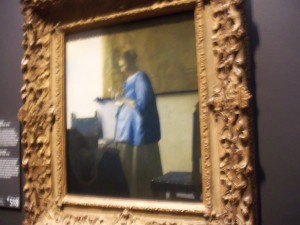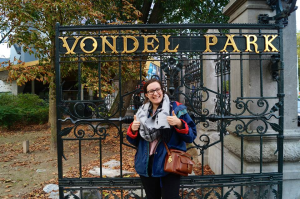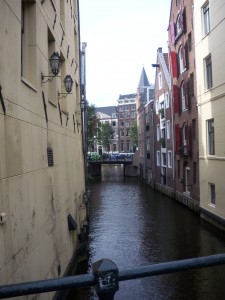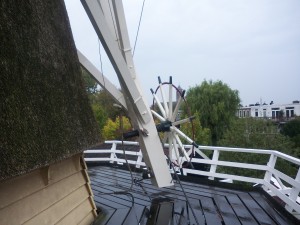So, in the free week between our German course and the beginning of the semester, my friend Charlotte and I decided to go to the Netherlands for a few days. One of the things that struck me the most was the number of bicycles in the Netherlands. Although we stayed in large metropolitan areas, there were often few busses or running cars to be seen, but instead an ocean of bicyclists. At first, this was a bit disarming, but once we learned the correct way to walk through a steady stream of bicyclists, it became easy to navigate. We first stayed in Amsterdam, which was basically a giant art tour.
On the first day, we spent about 4 hours walking through the Rijksmuseum, but I honestly could have spent all day if not for the lack of accessible bathrooms. It was absolutely fabulous to see such great works of art from such different periods of time, all of which were equally fascinating. The museum taught not only about Dutch art, but also about Dutch history.
Some of the highlights were:
On the next day, we went to the Van Gogh Museum. It was absolutely fabulous. Van Gogh is one of my favorite artists and seeing his work and the progression of his life was wonderful. I really liked seeing how his use of color and the wide brush strokes that are a signature of Van Gogh’s work evolved overtime. Many of the works from earlier in his life areMy favorite work was one of his self portraits, which I was unfortunately unable to photograph.
On the second to last day, I finally fufilled my dream of visiting Vondelpark, a large, Central Park-like area located at the southern end of Amsterdam that I had read a lot about and was excited to see. I was not disappointed. It was actually a beautiful piece of property that was a nice break from the hustle and bustle of the city and its bikes.
On the last day in Amsterdam we went to the North end of the city, located across the IJ lake and went to a great market and the EYE Film Institute which had some nice little exhibits about Dutch film, . Later, while waiting for the train to Utrecht, we waited at the public library, which aside from having a spectacular view, also had a lot of books. I took some time to just sit down and read, in Dutch, which is very linguistically similar to German, so much so that you can understand much of it without having learned the language.
Utrecht is a much smaller, although very friendly city that is packed with churches. There were 22 total each with its own unique set of bells that at times filled the airwaves in the city. I am a huge fan of churchbells. There is something about the unconscious keeping of time that is so beautiful about them. On our first night in Utrecht, we went on a Lumina Trajectum tour of the city. This consisted of a scavenger hunt for a bunch of lights throughout the city, its canals and landmarks that took us right through the old city of Utrecht. Later, when we visited one of the churches on the tour, Sint Wiliboald’s, I found an answer to a question that had been on my mind since coming to the Netherlands: why did it cost money to look at the churches? In Germany, churches are usually free of charge to visit and therefore one of the easiest ways to see beautiful architecture and history if you’re travelling on a budget, but since arriving in the Netherlands, we had only been able to find one or two churches that were open to the public. The answer I found lies in the structuring of the churches themselves. In Germany, the church is financed through a special tax that registered members of the church are required to pay, so there is always sufficient funding for church upkeep. In the Netherlands, congregations are separate organizations from the groups that own and maintain the church buildings (which may sometimes be the government). Therefore, the cost of maintaining the historical church buildings is not always covered by the congregation alone, but by the people who come to look at the churches.
One of my favorite parts of the entire trip was the tour of a sawmill we took while in Utrecht. It is one of only two working sawmills in the Netherlands and the tour that we got was absolutely amazing. The windmill, aside from being the Netherlands national symbol, is actually one of the things that helped to launch the Netherlands into the wealthy nation that it became during the first industrial revolution. Because of good wind catching land that existed in the Netherlands, sawmills were able to be easily built to process wood from places like the Black Forest in Germany, conveniently located just along the Rhein river.
I also enjoyed many, many Dutch foods. The first was Gevulde Koek, a cookie filled with marzipan. Marzipan is one my favorite foods, so combining it with basically anything was a winning combination for me. I also had some salted licorice. Many people do not like the strong and bitter taste of salted licorice, but I enjoy the herbal flavor that it has combined with its sourness.
I also enjoyed eating Gouda. Charlotte and I were trying to save money, so we decided to go shopping at the Dutch grocery store instead of eating out at every meal. I think that this is the best way to get to know a foreign culture, to stick your head in a grocery store and see what you can find through the everyday food that is offered. It was interesting just to look at the shelves and see what there was to eat. I found some lovely salmiak (salted licorice) that I enjoyed.
Overall it was a great trip. I really enjoyed seeing how a culture that seemed so similar to German culture on the surface could be so different once I learned a bit more about it.
Bis bald!







Leave a Reply